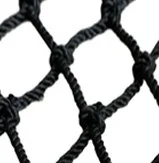Hay Net 101
Almost everything you need to know about hay nets:
Hay Net Materials: polyester, polypropylene (PPE), nylon
In general, polyester absorbs less water & stays softer than nylon
Net Structure: knotless or knotted
- primarily a personal preference.
- current research indicates no dental concerns
Hay Net Mesh (Hole Size):
Perhaps the more important choice is the size of holes in the hay net.
Bigger holes equal faster eating; smaller holes, slower eating.
Not all horses will tolerate the smallest hole (1”).
If you’re unsure of which hole size to choose, try a 1.5” hole net (sometimes offered as 1.75”). Some nets are as large as 4” holes, and are primarily designed to keep hay off the ground rather than slowing feeding down.
Hay Net Best Practices
Keep an empty hay net minimum 6” off the ground (adjust net length or placement of feeder to reach this minimum)
Head angle: Position nets so that the horse’s neck is in a downward angle from the withers
Not recommended for shod horses
Research Sources
Effect of hay nets on subluxations, pain-pressure thresholds, and cervical range of motion in the axial skeleton of adult horses (Journal of Equine Veterinary Science, February 2025) Hay nets can influence neck & cervical vertebrae; head position is important. Nets did not alter jaw, poll or wither pain-pressure thresholds.
Hay Nets, Horse Body Weight, Body Condition, and Dental Health (The Horse, September 19, 2024, based on the study linked in the previous listing) Hay nets can help horse owners reduce hay waste and prolong feeding time, which can reduce horse boredom and promote a more natural style of trickle feeding without negative effects to the horse’s dental health.
Studying the Shape Variations of the Back, the Neck, and the Mandibular Angle of Horses Depending on Specific Feeding Postures Using Geometric Morphometrics (Edited by Chris W Rogers; posted on National Library of Medicine, US) Different feeding positions are able to modify the shape of back and neck postures; best practice is head below height of withers, a more natural feeding position.
“How to use slow-feed haynets and slow feeders without endangering your horse’s limbs, hooves, and teeth” Article published in The Horse, April 19, 2021 by Christa Leste-Lasserre


